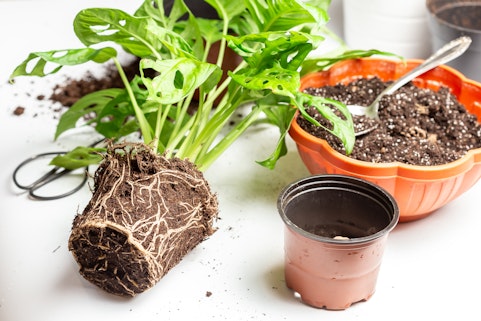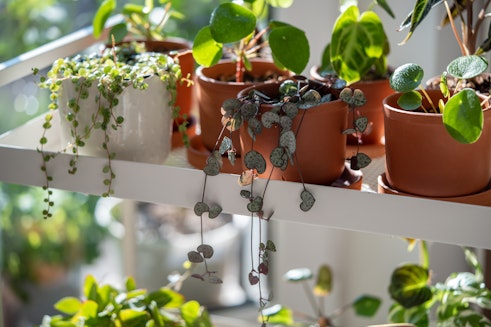
- Home
- Marantaceae Care Guide

For today’s post we are going to address the care for arguably one of the most attractive-looking of the plant groups; the Marantaceae family. They have some of the most striking and unusual foliage but along with those good looks comes quite a bit of confusion when it comes to keeping them happy. The plants we are talking about in this genera are Maranta, Calathea, Stromanthe and Ctenanthe. They are often referred to collectively as ‘prayer plants’ due to the way their foliage folds up and closes at night, as if in prayer. The first time I brought a Calathea warscewiczii home, I nearly jumped out of my seat when I could see its leaves moving out the corner of my eye! They really do like to move around and as one of their defining features it’s fascinating to watch every day.
Within the Marantaceae gang, I would say in my experience that there is definitely a 50/50 split in ‘ease of care’ - on one side is Maranta and Stromanthe varieties, and on the other is Ctenanthes and Calatheas. The first pair; Maranta and Stromanthe are the easier going option, and a great choice as ‘introductory’ plants into this group. Calathea and Ctenanthes tend to be a bit larger, and can sometimes be a bit of a headache in the wrong conditions!
Light
In terms of light, this is definitely a medium light plant - keep it away from those windowsills and bright sunshine or this will most certainly result in a crispy mess! Close to a north facing window would be ideal, but you’ll notice if your plant is getting too much light pretty quickly as the paper-y thin leaves will scorch and appear washed out in colour.
Watering
Aside from humidity (more on that later) watering is the issue that people struggle with most commonly in this plant group. Marantaceae really don’t like to be let to dry out between waterings and need to stay at a consistent level of moisture - the soil doesn’t want to be saturated or the plant pot sitting in water, but it certainly hates drying out. Often the marks you might notice on the foliage, or curling leaves is a result of inconsistent watering - often under-watering.

I have found a self watering spike to be really beneficial in my Stomanthe plant you can see in the photos, it’s got quite large over a few years and as a result, likes frequent watering. A self watering spike helps to keep things at a good moisture level and you can just water as normal, the spike is often not visible as it’s nestled amongst those lovely leaves! In terms of the type of water, it’s worth noting that these plants are actually quite sensitive to tap water, so if possible, opt for rainwater or distilled/filtered water to really help to deter those brown crispy edges. As with all plants, you’ll want to use tepid water - cold water can shock the roots.
Soil Mix
For my Marantaceae gang, I use my own concoction of potting mix - I find it easy that way to tailor the ‘blend’ to whichever plant I am potting with minimal fuss. I find a medium draining mix works well - nothing too light as the plant will dry out too quickly, and nothing especially heavy as the frequent watering could cause some root rot in a mix that is too dense. I use houseplant compost, perlite and orchid bark and my plants seem to like it!
Humidity
Perhaps the main culprit of marantaceae-related headaches is incorrect humidity. This is a bit of a dealbreaker and the most likely cause of those brown and dry edges making an appearance. Try and find the most humid spot in your home for them, huddling them in with other plants can help to increase humidity, use a water mat or a pebble tray, and if a humidifier is something you’d consider (they aren’t suitable for all homes) then your prayer plant really will be grateful. I must stress that this shouldn’t put you off getting one of these beauties - the average natural level of humidity in my apartment in Winter is around 50-60% and in Summer 60-70% and my plants have survived a number of years. If you can get the watering and medium light level right, this will help a great deal. Oh yes, and make sure you keep these beautiful plants away from cold draughts and heaters - dramatic temperature fluctuations can cause some harm.

As you can see from the photograph of my crispy Calathea Orbifolia leaf this November, this plant is a lot more likely to go like this than my Stromanthe, despite giving them exactly the same care. It just goes to show that Calathea are a bit fussier and not as tolerant to cooler temperatures as Stromanthe and Maranta varieties.
Pests
Inconsistent watering and low humidity are usually the main reasons your prayer plant might be susceptible to a pest or two; thrips and red spider mite are ones to look out for in warm, dry conditions. These plants like to be misted regularly to keep their delicately thin foliage free from dust, which is a good pest-deterrent too. The main method of prevention is keeping your watering routine up and increasing humidity where possible.

Fertilising
During the Spring and Summer, I feed my Marantaceae gang once a week with a balanced houseplant fertiliser and have found this helps to keep my plants healthy and strong. Over Autumn and Winter growth slows down and sometimes the foliage can die back a little bit, so you don’t want to feed during this time.
I hope this blogpost has helped you to get to grips with Marantaceae care, and that should you decide to add some to your collection, you’ll feel more confident in keeping them happy! If you have a bright, warm bathroom with medium light these prayer plants will do extremely well in those conditions. They aren’t the fastest of growers either so won’t take over your space too quickly!

Dr Laura Jenkins
Laura has a background in academia and started the blog 'House Plant House' as a creative outlet after finishing her PhD. She combined her interests in plants, design and interiors with her background in photography, art and writing and her blog is an excellent resource for plant care and design.
More by Dr Laura JenkinsRelated Articles
View all articles


General Houseplant Care
Propagating Plants - Making new plants from the ones you have already
By Jonathan Davies


